How To Pick A Good Watermelon
Here are six tips for How to Pick a Good Watermelon that’s ripe and sweet, gathered from lots of conversations with produce people, farmers, and personal experience. If you know how to check for things like the field spot, it makes the selection process much easier!
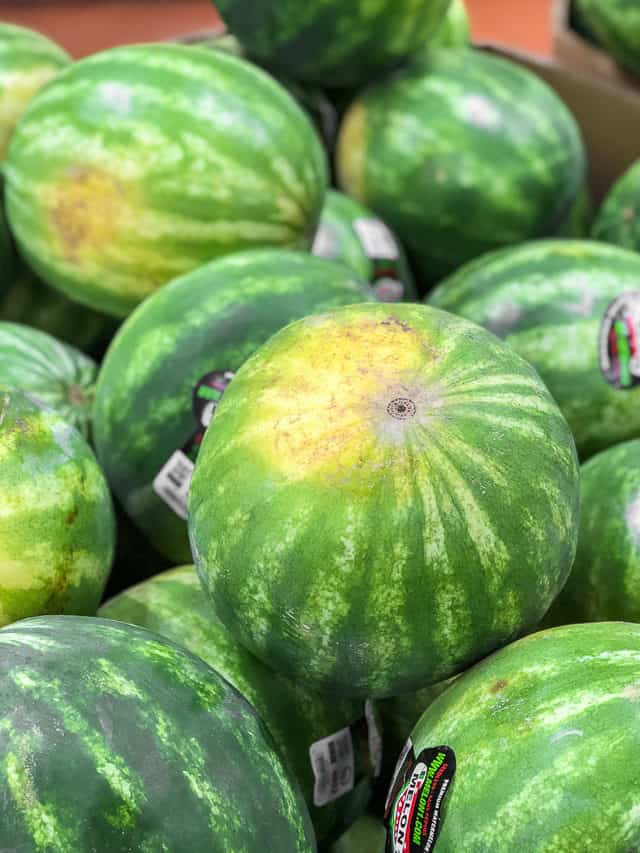
Picking out a perfect watermelon at the grocery store was always a semi-anxiety plagued experience for me when I didn’t know what I was looking for.
If you pick a bad one, you’re stuck with 15-20 whopping pounds of watermelon terribleness. And then your options are to either force yourself to eat this yucky watermelon or throw it away…and both are less than desirable options.
There have been a few times where I ended up throwing it out because it tasted like a crunchy watermelon rind cucumber, and no one in my family would eat it.
My goal today is to help you pick a sweet, ripe watermelon because I know how disappointing it is to get home, take your first bite of some sort of produce you buy, only to find out it isn’t good.
All the tips here are tidbits I have gathered from personal experience and lots of conversations with produce people and farmers. Here’s how to pick the best watermelon!
Tip #1: Find the Field Spot
If you don’t even read the other tips, I find this is the biggest indicator of a good watermelon.
The field spot, or ground spot, is a creamy spot on the outside, and it’s where the watermelon was resting on the ground, or the underside of the watermelon.
The field spot should be a yellowish creamy color, like shown with my watermelon:
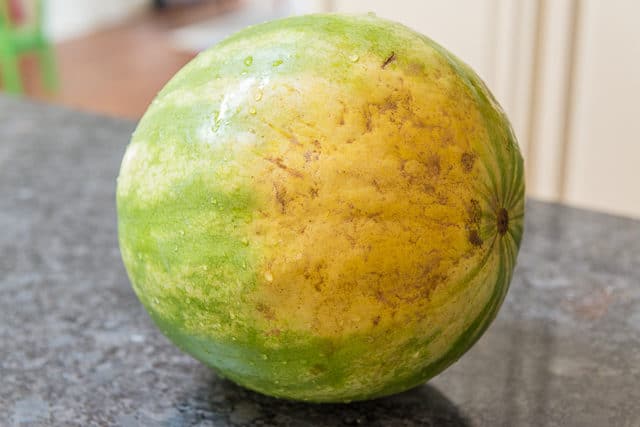
The more dark yellow the field spot is, the longer it was on the vine sweetening up. If the field spot is a white spot (or not even there), this indicates an underripe melon.
What’s interesting is you’ll notice that the other side of the same watermelon looks completely different:
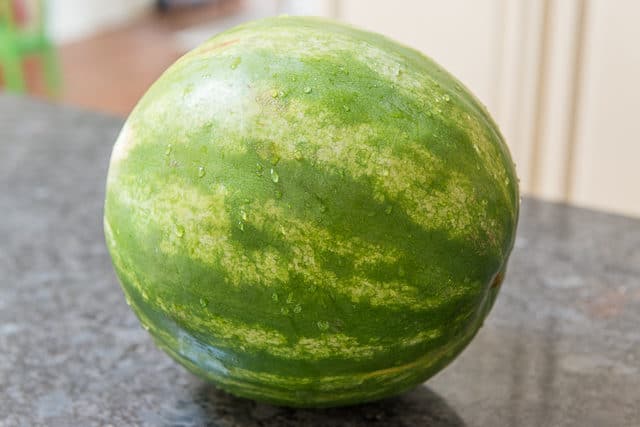
It’s much prettier and more typical of what I picture when I think of a watermelon, and that’s okay.
I find that the best watermelons I buy can sometimes look really gnarly on one side, usually the underside of the melon where it was resting on the ground, and then unblemished on the other. But you don’t want it to look perfectly green all the way around.
Note: It’s fine if there are green stripes, or not, or if there’s solid green color on most of the outside of the watermelon. The exterior pattern is more about the varieties of watermelons that your grocery store carries, and not anything to do with being a ripe melon or not.
Tip #2: Pick a Dull Looking Exterior
A shiny exterior appearance indicates an underripe watermelon, though this can be a bit tricky if they’ve added wax, and then you can’t really tell. This applies to honeydew melons too. Don’t be put off by a dull looking watermelon.
Tip #3: Knock on It with Your Knuckles
Your knuckles should bounce off the melon, and the surface should be pretty hard and firm. You will get a dull thud if the flesh is soft, which indicates it’s starting to spoil. Avoid any melon with soft spots!
Rather than a dull thud, you are looking for a hollow sound, a deep sound. It takes a lot of testing to learn what this sounds like, so don’t use it as your only indicator.
If you don’t want to knock with your knuckles, then you can push firmly with the tip of your thumb. Ideally there should be little or no give when you push in.
Tip #4: Get the Heaviest One for Its Size
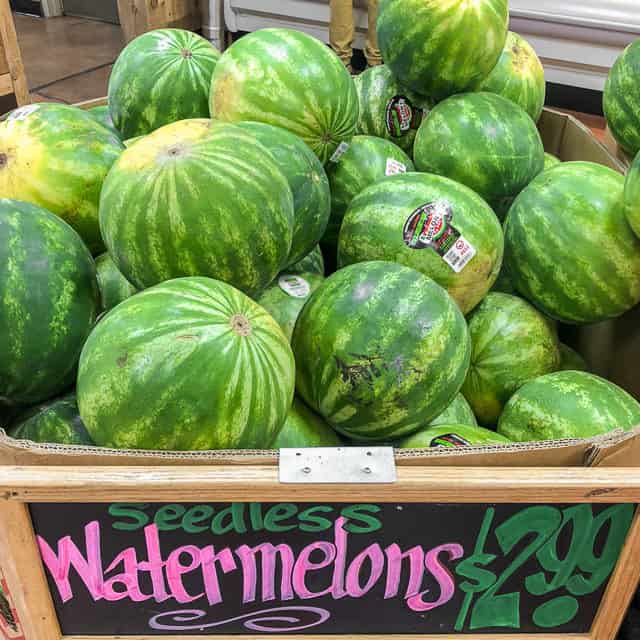
This applies to pretty much all produce, but you want to pick a heavy watermelon, meaning the one that is the heaviest for its size. That means there’s more water in it, which means a juicy watermelon.
The easy way to check for this is to pick up a few melons and compare their weights (or, if there’s a scale nearby, actually weigh them).
The whole watermelon pictured above here in my post was a whopping 18 pounds! It was heavier than the other comparably sized melons around it. It’s more bang for your buck too.
Tip #5: Check for a Uniform Shape
Some watermelons are round, some are oval, and either is fine. They are just different varieties. But if there are irregular bumps, this indicates the melon may have gotten inconsistent amounts of sun or water, and you should avoid that one.
Tip #6: Look for the Sugar Spots and Pollination Points
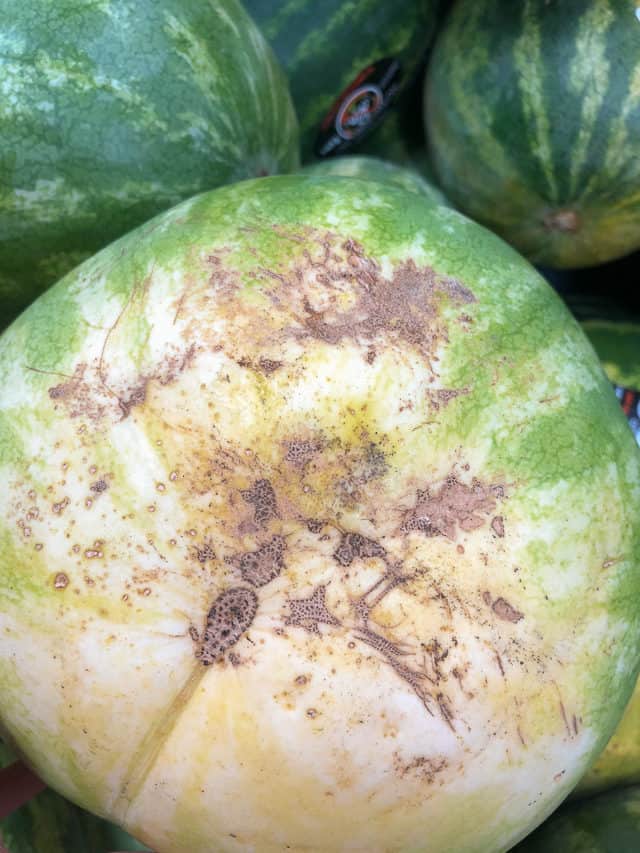
This tip was emailed to me many months ago by Tom, a produce manager for a major grocery chain. If you see black spots on the melon (as pictured above), this is where sugar is seeping out and indicates a sweet melon. At first glance, a sugar spot might just look like dirt, but if it doesn’t rub off easily, then it’s a sugar spot.
Also, if you see dots in a line (not a scratch), these are pollination points, and the more of them the better. I’ve been looking for these every time I pick up a melon and have had great luck with it in addition to the other tips. Thank you, Tom!
Though the above melon did not have a creamy yellow spot (it’s a little white), the sugar spots are a good sign. It was indeed a sweet watermelon.
What about the stem?
I’ve never seen a watermelon with its green stem on, though perhaps you’re more likely to find one at a farmers market. Odds are it won’t come up anyway, but I don’t know if any ripeness indications from the stem.
Once you’ve picked out a good watermelon, take a look at my quick guide for How to Cut a Watermelon, which is how I always cut watermelon to keep in the fridge. But is especially the best way to serve this delicious fruit for parties and entertaining.
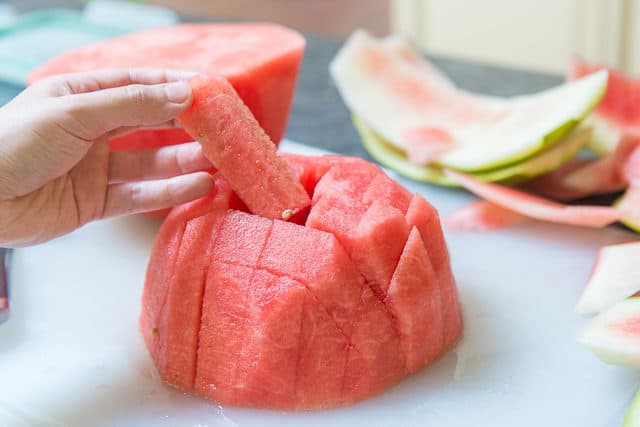
The middle of the watermelon always has the best flavor, so you’ll want to cut away a substantial amount of rind.
This method of cutting is SO much easier than cutting the typical triangles that include the rind, and you can either cut it into sticks or cubes. My perfect slice is actually the stick!
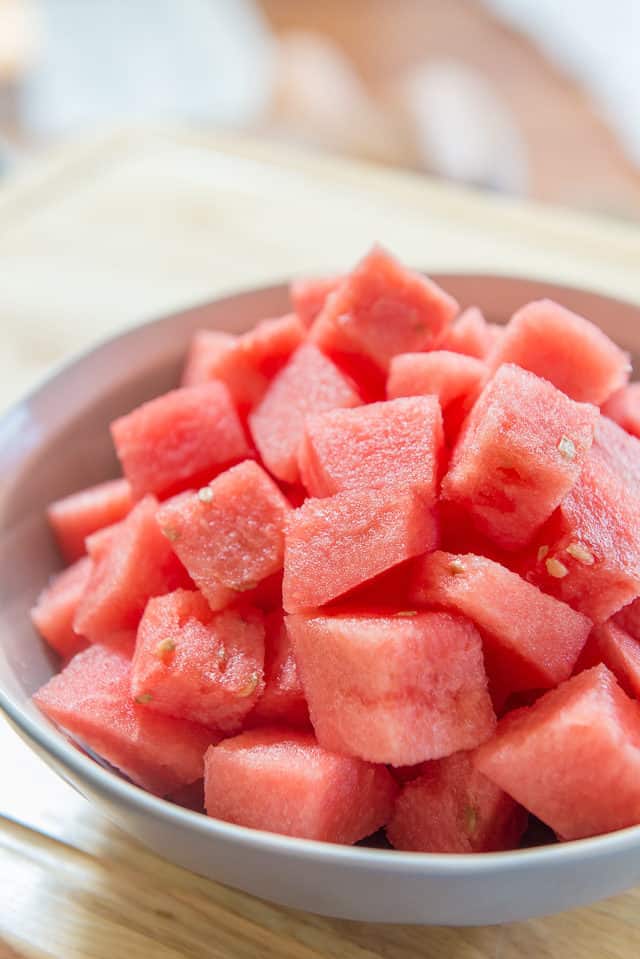
Just make sure to use a sharp knife so you get crisp pieces.
Click the photo above for my guide on cutting. Enjoy watermelon season!
More Tips and FAQ
If it’s cut, the watermelon must be stored in the fridge and can be kept in a large container for up to 5 days. An uncut watermelon can be kept at room temperature for a few days, but I find it’s best to get it into the fridge as quickly as possible, especially since watermelons do not ripen further on the counter.
Yes, but it’s not something you’ll want to eat again in a thawed state. I freeze watermelon to blend into a Watermelon Slushie or as ice cubes for Summer Drinks.
In the South they serve pickled watermelon rinds as a kind of relish, and it’s very good! I’ve never made it myself though. Only had it in restaurants.
Did you enjoy the recipe? Please leave a 5-star rating in the recipe card below and/or a review in the comments section further down the page. Or, follow me on Facebook, Instagram or Pinterest!
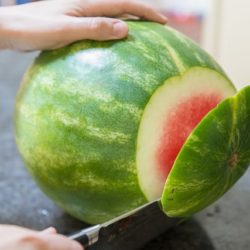
How to Pick a Good Watermelon
Ingredients
- 1 large watermelon
Instructions
- Find the Field Spot – Look for a deep yellow color. If there’s a white field spot, or no field spot at all, it likely won’t be good.
- Pick a Dull Looking Watermelon – A shiny appearance indicates an underripe melon.
- Knock on It with Your Knuckles – Your knuckles should bounce off the melon, and the surface should be pretty hard/firm. Soft flesh indicates it’s starting to spoil.
- Get the Heaviest One for Its Size – This applies to pretty much all produce, but you want to pick the watermelon that is the heaviest one for its size. That means there’s more water in it.
- Check for a Uniform Shape – Some watermelons are round, some are oval, and either is fine. But if there are irregular bumps, this indicates the melon may have gotten inconsistent amounts of sun or water.
- Look for the Sugar Spots and Pollination Points – If you see black spots on the melon, this is where sugar is seeping out and indicates a sweet melon. Also, if you see dots in a line (not a scratch), these are pollination points, and the more of them the better.
- If you want an easy way to cut the watermelon into sticks or cubes, see my How to Cut a Watermelon post. Enjoy!
Nutrition
Nutrition is estimated using a food database and is only intended to be used as a guideline for informational purposes.
Post updated with new photos and more tips in June 2018. Originally published April 2011.

288 Comments on “How To Pick A Good Watermelon”
A farmer told me to look at the stem end–if it’s an “innie” that means it’s ripe. If the stem end is pointed out, it was picked too early. This applies to all melons. Once I learned that trick, I haven’t picked a bad melon yet!
I loved the video and I loved the advice. I just brought home a mushy watermelon and it made me so unhappy. I will definitely pick out my next watermelon using your suggestions.
I go by the stem…or lack of there of…if the stem is still attached it means the melon was “picked”…if there is a clean smooth spot where the stem once was…that means the melon was ripe enough to pick therefore, ripe and sweet…
Hi Joanne, I think I´m reading a bit too late this post, here in Chile watermelons are at the end of the season…
About the 3rd tip you wrote, according to my produce supplier, you must knock during the morning, this is because when the temperature goes up, the fruit heats a bit so every watermelon will sound similar. Works for me 😉
Thank you for your helpfull advices, will have them in mind for next summer!
Maria
Santiago, Chile
Fantastic advice and great photography. Makes me want to go out and buy one.
I thought I was the only one who agonized over picking out a watermelon, and how utterly disappointing it is to get a bad one! Thank you for the tips!
My produce manager once told me to look for what he referred to as bloodspots- on either end of the melon- or in a spot where the melon has some kind of scar- if it is a really sweet melon the juice will come to the surface and the air will cause the sugar to harden so it sort of looks like hardened blood- hence the name ” bloodspots” this advice has never failed me- I’ve always gotten the sweetest melons!
Thank you for the watermelon & cutting tips. Seems I always pick bad ones and never really learned how to cut them as well.
You make it look so simple
Thank you,
Karen
Bakersfield, CA
is it just me, or was 2013 a sort of bad year for watermelon generally…?
Haha, I guess so, Caligirl, but I just thought that was my husband! 😉
Thanks for a few more tips!!
I don’t use a cutting board, but instead I use an oversized cafeteria style serving tray and it works great in catching juice or melon fragments and since the tray lip is one inch high there’s no worry about juice “runoff”.
Great tip, thanks for sharing!
All the tips n comments featured r about red, symmetrical watermelons but wat about yellow fleshed ones…? do I use the same tips..? Or how do I cut an irregular shaped ones in half w/o either side appearing too big/small?
I also look for a green stem to indicate it was picked more recently.
My best bet for getting a good watermelon is to choose the Dulcinea Pure Heart brand of seedless “personal size” watermelons. They are usually sweet all the way to the rind, are truly like eating only the heart of a melon, and are not too big for my family of two to deal with.
I like the personal size melons also–much less rind and they don’t take up much room in the fridge once cut.
I just cut up that watermelon like a boss! Thanks for the tutorial.
Woohoo!!!
I have always found yummy melon.Besides what you have said i always look for brown scars,(i have read they are formed because the thing is growing to fast and it is kind of a tare,and i have heard it is where insects (bees) have went after it for its sweetness).And Yes you dont want a mushy feel to any part of it.And if you know how to become one with the melon (be the melon) that will certainly help.
HI 🙂 .. yes the knocking is useful in BOTH aspects (sound and feel) .. the little black bumps are actually caused by insects but not bees, and yes they are attaracted to the sweetness, and im not sure what they are but they use a probiscus like a mosquito hence the dots of dried sap …. as for determining if a melon is almost too ripe, when a melon ripens the juice tends to gather , so if it is lying on a surface the liquid will pool to the lower half of the melon .. a gentle roll along the floor will tell you if it has a pool on the bottom as it won’t roll easily (not like a firm just ripened on).